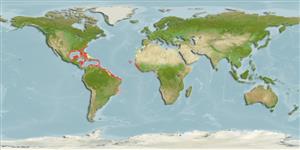>
Holocentriformes (Squirrelfishes, soldierfishes) >
Holocentridae (Squirrelfishes, soldierfishes) > Myripristinae
Etymology: Myripristis: Greek, myros, -ou = male of morey eel + Greek, pristis = saw (Ref. 45335).
More on author: Cuvier.
Environment: milieu / climate zone / depth range / distribution range
Écologie
marin récifal; profondeur 0 - 210 m (Ref. 115215), usually 2 - 35 m (Ref. 40849). Subtropical; 37°N - 23°S, 98°W - 9°E
Western Atlantic: North Carolina (USA), Bahamas and northern Gulf of Mexico to Brazil; throughout the West Indies and the Caribbean Sea (Ref. 3724). Eastern Atlantic: St. Paul's Rocks (Ref. 13121), Cape Verde, Principe, Ascension and St. Helena islands (Ref. 6537).
Taille / Poids / Âge
Maturity: Lm ? range ? - ? cm
Max length : 25.0 cm TL mâle / non sexé; (Ref. 5217); common length : 20.0 cm TL mâle / non sexé; (Ref. 5217)
Épines dorsales (Total): 11; Rayons mous dorsaux (Total): 14; Épines anales 4; Rayons mous anaux: 13 - 14. Soft dorsal and anal fins covered with scales (Ref. 13608). Dark brown vertical bar runs along gill opening to pectoral fin (Ref. 26938). Body deep, compressed and robust (Ref. 37108). Body reddish above, paling to silvery below. Spinous dorsal fin with red and white markings. Edges of all fins are white. Preopercular spine not prominent. Lobes of caudal, soft dorsal and anal fins pointed (Ref. 7251).
Found from shallow coral reefs to offshore deeper waters (Ref. 3724). A nocturnal species aggregating around coral reefs and deeper rocky reefs (Ref. 3724). Feeds mainly on planktonic organisms (Ref. 3724). Occasionally found swimming upside down (Ref. 9710). Marketed fresh but not popular as a food fish (Ref. 5217).
Life cycle and mating behavior
Maturité | Reproduction | Frai | Œufs | Fécondité | Larves
Robins, C.R. and G.C. Ray, 1986. A field guide to Atlantic coast fishes of North America. Houghton Mifflin Company, Boston, U.S.A. 354 p. (Ref. 7251)
Statut dans la liste rouge de l'IUCN (Ref. 130435)
Menace pour l'homme
Harmless
Utilisations par l'homme
Pêcheries: intérêt commercial mineur; Aquarium: Commercial
Plus d'informations
RéférencesAquacultureProfil d'aquacultureSouchesGénétiqueElectrophoresesHéritabilitéPathologiesTraitementNutrientsMass conversion
Outils
Articles particuliers
Télécharger en XML
Sources Internet
Estimates based on models
Preferred temperature (Ref.
123201): 23.6 - 28, mean 26.6 °C (based on 652 cells).
Phylogenetic diversity index (Ref.
82804): PD
50 = 0.5000 [Uniqueness, from 0.5 = low to 2.0 = high].
Bayesian length-weight: a=0.01445 (0.00808 - 0.02587), b=3.00 (2.85 - 3.15), in cm total length, based on LWR estimates for this species & Genus-body shape (Ref.
93245).
Niveau trophique (Ref.
69278): 3.4 ±0.2 se; based on diet studies.
Résilience (Ref.
120179): Haut, temps minimum de doublement de population inférieur à 15 mois (Preliminary K or Fecundity.).
Fishing Vulnerability (Ref.
59153): Low vulnerability (15 of 100).
Nutrients (Ref.
124155): Calcium = 39.6 [16.0, 105.5] mg/100g; Iron = 0.697 [0.277, 1.494] mg/100g; Protein = 19.2 [17.9, 20.3] %; Omega3 = 0.284 [0.111, 0.698] g/100g; Selenium = 21.1 [10.5, 42.4] μg/100g; VitaminA = 42.4 [14.1, 136.7] μg/100g; Zinc = 0.874 [0.531, 1.408] mg/100g (wet weight);
